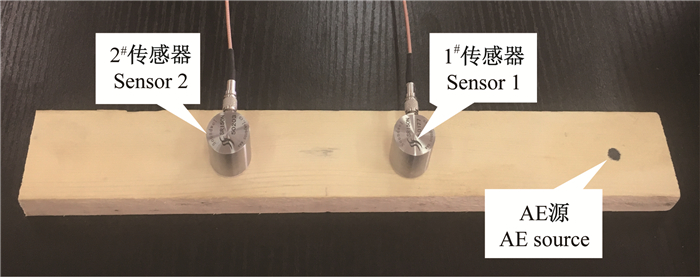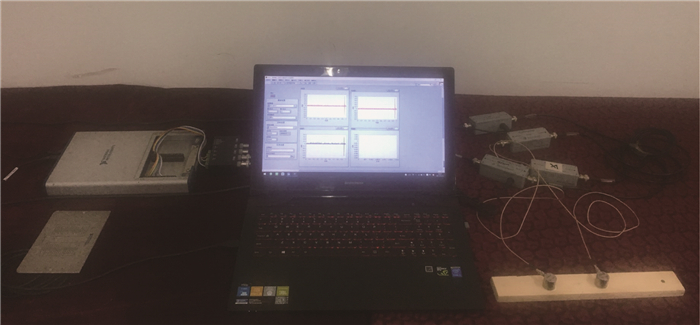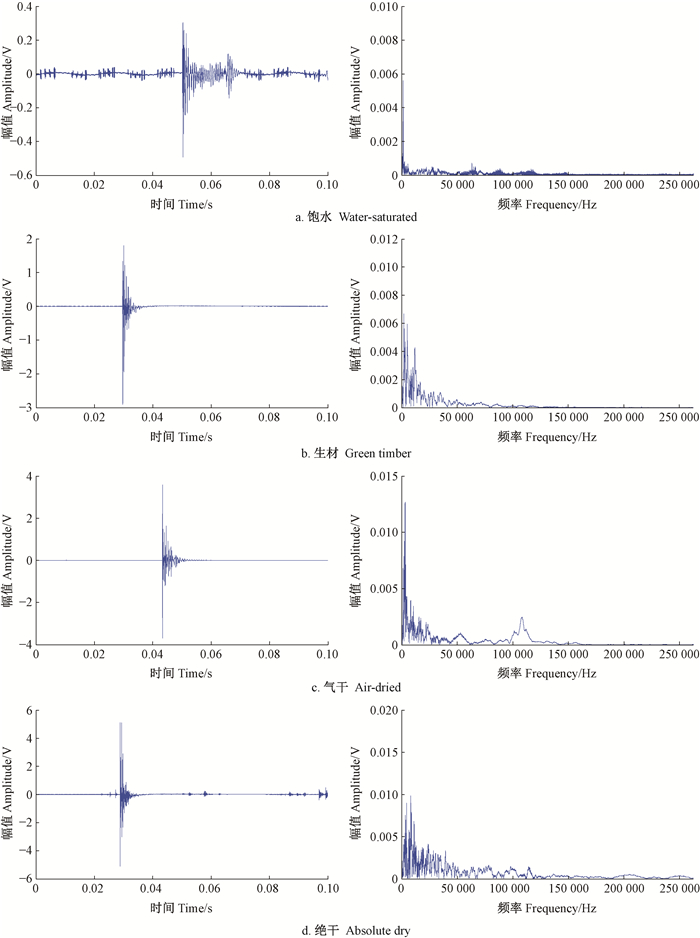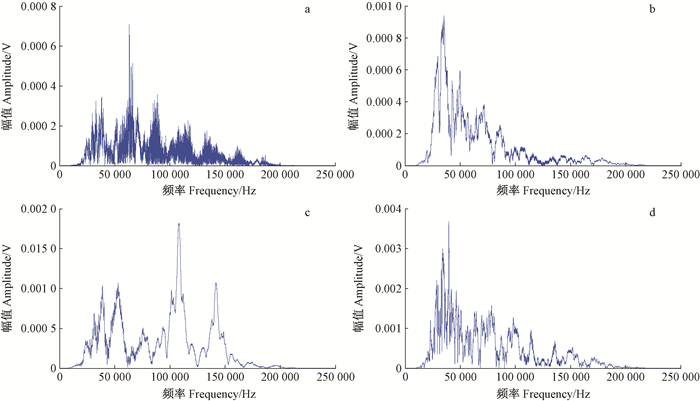文章信息
- 李杨, 许飞云.
- Li Yang, Xu Feiyun.
- 不同含水率云南松声发射信号特征
- Acoustic Emission Signal Characteristics of Pinus yunnanensis with Different Moisture Content
- 林业科学, 2019, 55(6): 96-102.
- Scientia Silvae Sinicae, 2019, 55(6): 96-102.
- DOI: 10.11707/j.1001-7488.20190612
-
文章历史
- 收稿日期:2017-05-27
- 修回日期:2017-07-08
-
作者相关文章
木材是森林的主产品,是一种天然的可再生资源,独具形、色、香、质、纹、理等特点,近年来逐渐成为结构建筑主要用材。然而,由于木材内部结构复杂且易受外部环境影响,在加工处理过程中,常因受内力和外力作用而产生形变和开裂,从而降低木材的力学性能(范文俊等,2015;林兰英等,2015)。针对木材表面产生的形变,可以利用应变测定仪等进行检测,但诸如此类的常规手段无法实时监测木材内部的形变和开裂,因此,发展一种有效且对材料无损的检测方法具有十分重要的意义。
声发射(acoustic emission,AE),也称应力波反射,是指物体中局域源快速释放能量产生瞬态弹性波的现象,通过分析被测物体内部因能量变化所引发的弹性波特征,可判断物体内部损伤程度并确定损伤位置(Dunegan et al., 1968)。声发射技术是通过对AE信号的处理、分析来评价缺陷的发生、发展规律并确定缺陷位置的,其为木材加工处理过程中的应力监测提供了一种主动无损检测方法。Ritschel等(2013;2014)对胶合板层积材(plywood)和实木(wooden planks)进行50%应力水平下的拉伸试验,结果发现胶合板层积材AE事件数较少,实木AE事件累计呈线性增长;Lamy等(2015)采用不同方法监测花旗松(Pseudotsuga menziesii)试件的破坏过程,通过比较发现,AE信号的特征参数是反映木材开裂发生和发展的有效信息,AE信号源定位方法可以标定木材损伤过程中的断裂过程区;Baensch等(2015)分析云杉(Picea asperata)拉伸过程中AE信号的频率范围,并采用无监督模式识别方法对AE信号进行了分类。邵卓平等(2009)研究木材三点弯曲破坏过程的AE特性发现,试件加载初期会产生一些较低振幅的AE信号,大量高振幅的AE信号出现在峰值载荷附近和韧性断裂阶段;丁小康等(2012)对木材干燥过程中的AE信号特征进行研究,指出自由水蒸发阶段会产生高频低幅的AE信号,而木材出现开裂形变时会发出大量高幅值、高能量的连续AE信号;申珂楠等(2015a;2015b;2015c)采用AE传感器、多通道高速数据采集设备构建木材AE信号采集系统,基于LabVIEW软件设计AE信号波形的小波析取和分析平台,利用时差法计算AE信号在木材表面的传播速度,进一步提出了木材表面AE信号源的三角形定位方法,运用AE技术分析三点弯曲试验中木材的损伤断裂过程,给出了不同阶段的AE信号波形及相应的频域特征参数。需要指出的是,现有对木材AE检测的研究大多采用单一含水率试件,而含水率是影响木材AE信号传播速率的主要因素;同时,由于木结构建筑长期暴露在空气中,极易受水分子影响而降低木材的物理性能,且不同含水率下木材AE信号波形的传播规律如何目前尚不清楚。
鉴于此,本研究以云南松(Pinus yunnanensis)为试验材料,采用NI高速采集设备和LabVIEW软件构建AE信号采集平台,利用铅芯折断模拟声发射源,对绝干、气干、生材和饱水4种含水率状态下的试件表面进行AE信号采集,通过时差法计算信号在4种含水率状态下的平均传播速率,并运用小波分析对AE信号波形进行分解和重构,探讨含水率对AE信号波形的响应,以期为云南松声发射源定位提供依据,为木材内部缺陷无损检测提供基础数据。
1 材料与方法 1.1 试验材料为了能较明显地探究不同含水率下木材AE信号特征,以含水率139.1%(饱水状态)、81.3%(生材状态)、13.5%(气干状态)以及绝干状态的云南松作为研究对象,制作试件尺寸为350 mm(L)× 50 mm(T)×40 mm(R)。利用铅芯折断模拟声发射源(铅芯型号为0.5 mm,断铅角度保持正向60°),并在距声源100和200 mm处各放置一个传感器(图 1),各通道的采集电压幅值设置为(-5 V,5 V),采样频率为500 kHz。

|
图 1 传感器连接实物 Fig. 1 Physical diagram of sensor connection |
首先对原始状态含水率为13.5%(气干状态)的试件浸泡指定时间,并选用真空干燥箱结合称重法计算各自含水率。根据文献(Wolkerstorfer et al., 2012;孙丽萍等,2013;廖立等,2013),大多数木材AE信号的频率范围为50~200 kHz,为此本研究选用SR150 N声华单端谐振声发射传感器,其采集频率在20~200 kHz之间,传感器配置增益40 dB的PAI前置放大器,放大器内置降噪装置,能有效放大信号,同时减少噪声信号。此外,为了满足香农采样定理(也称奈奎斯特定理)的基本要求,采用USB-6366 NI高速采集卡搭建基于LabVIEW软件的AE信号采集平台,设备采样频率最高可达2 MHz,在试件与传感器接触表面涂上一层专用耦合剂,以保证AE信号能够较好地到达传感器,并实现对试件AE信号的采集(图 2)。

|
图 2 声发射采集系统 Fig. 2 Acoustic emission collection system |
为进一步探究试件内部的应力集中情况,考虑小波分析在时、频域均能表征信号的局部特征(许中林等,2014;黄金波等,2013),本研究结合Matlab程序对AE信号进行小波分解,将信号分成不同频段的信号,并剔除含有噪声的信号频段,对含有AE信号频段的信号进行重构,从而将“淹没”在噪声中的AE信号析取出来;同时,依据AE信号到达2个传感器的时间差,估算其在不同含水率试件表面的轴向传播速度。
2 结果与分析本研究对4种不同含水率试件各进行5组断铅试验,相应的平均传播速率见表 1。由表 1可知,随着含水率增加,AE信号在云南松表面的平均传播速率逐渐减小,减小幅度在20.8%~39.2%之间;各含水率状态之间平均声速差范围为876.98~1 003.06 m·s-1,且在绝干状态下试件的平均声速达到最大值4 208.77 m·s-1,在饱水状态下达到最小值1 414.07 m·s-1,满足木材的基本特性(刘昊等,2014;彭辉等,2016)。
|
|
图 3所示为各含水率(饱水、生材、气干以及绝干状态)试件经过断铅试验产生的AE信号。可以发现,随着含水率增加,水分子将分散铅芯折断产生的作用力,降低材料在外力作用下释放的应变能,从而使试件AE信号的时域波形幅值呈明显递减趋势,且在饱水状态时幅值区间仅在(-0.6 V,+0.4 V),而在绝干状态幅值最高可达±5.2 V。由此可见,水分子对云南松试件表面AE信号传播具有一定阻碍,导致含水率较高的试件时域波形幅值减弱明显(由于均在试件表面接收AE信号,试验中传感器均以接收表面波信号为主)。

|
图 3 4种含水率状态下的AE信号时域波形和频谱 Fig. 3 Time domain waveform and frequency spectrum of AE signal under four water-bearing states |
受试件含水状态和外部环境影响,AE信号衰减严重而“淹没”在噪声中。为了更大程度减少误差,在分析信号特征之前需要对其进行预处理,去掉混杂的噪音,从而将AE信号从噪声中析取出来(范博楠等,2015)。考虑小波分析提取信号的绝对优势,本研究选用Daubechies小波中常用的db5小波作为小波基对采集的信号进行7级小波分解,同时采用软阈值对各高频层系数进行量化,去除非主能量分解信号,并基于阈值量化处理后的高频层系数对信号进行小波重构(图 4)。

|
图 4 4种AE信号小波分解重构频域波形 Fig. 4 Wavelet decomposition and reconstruction waveform of four kinds of AE signals a.饱水Water-saturated;b.生材Green timber;c.气干Air-dried;d.绝干Absolute dry. |
由于本研究采用的传感器采集频率在20~ 220 kHz之间,因此在对信号进行小波分解前需将频率小于20 kHz的信号滤掉。对比图 3、4发现,小波变换可将试件的AE信号从噪声中析取出来,且保持原始信号特征;同时在4种不同含水率状态下,AE信号的频率范围均在40 ~150 kHz之间,其中气干状态频率峰值达110 kHz左右,其他3种状态频率峰值均在50 kHz左右。由于水分子会降低材料内部产生的应变能,因此随着含水率增加,试件的AE信号频域幅值呈衰减趋势。
3 讨论不同含水率条件下,煤与瓦斯突出(许江等,2015)、煤岩(陈春谏等,2018)以及泥质粉砂岩(张安斌等,2017)和红砂岩(文圣勇等,2013)破裂过程的AE特性研究表明,在外加载荷相同条件下,弯曲过程中AE事件的最大幅值、高幅值试件的计数率等均随含水率增加而降低,且AE事件计数的集中区域有从大幅值向小幅值转移的趋势。目前国内外对不同含水率木材的声发射特性研究甚少,这种情况在木材弯曲过程中是否存在还需要进一步研究。
同时,在砂岩单轴压缩过程中,由于其脆性较大,随着含水率增加,试样的单轴抗压强度下降;此外,水分子对砂岩力学特性和AE特征有较大影响,含水砂岩对AE振铃数比干燥试件少且滞后,但不同含水率试样所得声发射累计振铃数曲线在形状上相似。木材和砂岩均属脆性材料,因此在木材单轴压缩过程中,含水率对其AE信号特性的影响是否也与砂岩材料类似仍需要进一步研究。
本研究主要探讨含水率对云南松试件AE信号传播规律的影响,就实际应用而言,仍有许多问题亟待解决,如损伤过程中不同含水率对木材AE事件产生的作用以及对不同含水率试件的AE源定位结果的影响等。另外,实际木结构建筑或地下工程中木质梁柱通常接近或位于地下水以下,地下水对声发射探测的影响目前还不清楚。
4 结论随着含水率增加,AE信号的时域波形幅值呈衰减趋势;AE信号在试件表面传播的平均速率与含水率呈反比,在绝干状态下平均声速达到最大值4 208.77 m·s-1,而在饱水状态平均声速仅为1 414.07 m·s-1;从重构后的信号频域分布可以发现,4种含水率状态下试件的频域波形均主要集中在40~150 kHz之间,且气干状态下波形峰值出现在110 kHz左右,其他3种含水率状态均在50 kHz左右达到峰值。
针对AE信号中混有噪声的问题,本研究选用小波分析法能够很好地将信号从噪声中析出,并保持原始的信号特征,然而由于小波基种类繁多且不同小波基的分析结果不同,因此未来可考虑采用小波包分析法对AE信号进行去噪。同时,可在本研究基础上,对不同含水率云南松受压变形破坏全过程的声发射特征进行探讨,以为其声发射源定位提供一定的数据支持。
陈春谏, 赵耀江, 郭胜亮, 等. 2018. 不同含水率煤岩声发射特性试验研究. 煤矿安全, 49(5): 40-46. (Chen C J, Zhao Y J, Guo S L, et al. 2018. Experimental study on acoustic emission characteristics of coal with different moisture content. Safety in Coal Mines, 49(5): 40-46. [in Chinese]) |
丁小康, 张祥雪, 郝燕华, 等. 2012. 木材干燥过程中声发射信号分析. 木材工业, 26(3): 40-43. (Ding X K, Zhang X X, Hao Y H, et al. 2012. Acoustic emission analysis during small thin wood samples. China Wood Industry, 26(3): 40-43. DOI:10.3969/j.issn.1001-8654.2012.03.011 [in Chinese]) |
范博楠, 王海斗, 徐滨士, 等. 2015. 强背景噪声下微弱声发射信号提取及处理研究现状. 振动与冲击, 34(16): 147-155. (Fan B N, Wang H D, Xu B S, et al. 2015. Present research situation of the extraction and processing of weak acoustic emission signals under strong background noise. Journal of Vibration and Shock, 34(16): 147-155. [in Chinese]) |
范文俊, 涂登云, 彭冲, 等. 2015. 热处理对毛白杨木材力学性能的影响机理. 东北林业大学学报, 43(10): 88-91. (Fan W J, Tu D Y, Peng C, et al. 2015. Influence of heat treatment on mechanical properties of Populus tomentosa wood. Journal of Northeast Forestry University, 43(10): 88-91. DOI:10.3969/j.issn.1000-5382.2015.10.018 [in Chinese]) |
黄金波, 王志刚, 刘昌明. 2013. 基于小波变换的镁碳质耐火材料受压损伤声发射特征分析. 材料导报, 27(16): 139-142. (Huang J B, Wang Z G, Liu C M. 2013. Analysis of the acoustic emission characteristics of MgO-C Refractory damage under compressive load based on wavelet transform. Materials Review, 27(16): 139-142. DOI:10.3969/j.issn.1005-023X.2013.16.036 [in Chinese]) |
廖立, 涂登云, 李重根, 等. 2013. 热处理对尾赤桉木材物理力学性能的影响. 中南林业科技大学学报, 33(5): 128-131. (Liao L, Tu D Y, Li C G, et al. 2013. Effects of heat treatment on physical-mechanical properties of E.urophylla×E.camaldulensis. Journal of Central South University of Forestry, 33(5): 128-131. DOI:10.3969/j.issn.1673-9272.2013.05.033 [in Chinese]) |
林兰英, 秦理哲, 傅峰. 2015. 微观力学表征技术的发展及其在木材科学领域中的应用. 林业科学, 51(2): 121-128. (Ling L Y, Qin L Z, Fu F. 2015. Development of micromechanical technique and application on wood science. Scientia Silvae Sinicae, 51(2): 121-128. [in Chinese]) |
刘昊, 高建民. 2014. 含水率和密度对木材应力波传播速度的影响. 北京林业大学学报, 36(6): 154-158. (Liu H, Gao J M. 2014. Effects of moisture content and density on the stress wave velocity in wood. Journal of Beijing Forestry University, 36(6): 154-158. [in Chinese]) |
彭辉, 蒋佳荔, 詹天翼, 等. 2016. 木材密度和含水率对其轴向超声波传播速度的影响. 林业科学, 52(10): 117-124. (Peng H, Jiang J L, Zhan T Y, et al. 2016. Influence of density and moisture content on ultrasound velocities along the longitudinal direction in wood. Scientia Silvae Sinicae, 52(10): 117-124. DOI:10.11707/j.1001-7488.20161015 [in Chinese]) |
邵卓平, 陈品, 查朝生, 等. 2009. 木材损伤断裂过程的声发射特性与Felicity效应. 林业科学, 45(2): 86-91. (Shao Z P, Chen P, Zha C S, et al. 2009. Acoustic emission characteristics of damage and fracture process of wood and felicity effect. Scientia Silvae Sinicae, 45(2): 86-91. DOI:10.3321/j.issn:1001-7488.2009.02.016 [in Chinese]) |
申珂楠, 丁馨曾, 赵海龙, 等. 2015a. 木材表面声发射信号源的三角形定位方法. 东北林业大学学报, 43(4): 77-81. (Shen K N, Ding X Z, Zhao H L, et al. 2015a. Acoustic emission signal source localization in wood surface with triangle positioning method. Journal of Northeast Forestry University, 43(4): 77-81. [in Chinese]) |
申珂楠, 赵海龙, 丁馨增, 等. 2015b. 基于LabVIEW的木材声发射信号采集与小波析取. 中南林业科技大学学报, 35(4): 125-129. (Shen K N, Zhao H L, Ding X Z, et al. 2015b. Wood acoustic emission signal acquisition and wavelet extraction based on LabVIEW. Journal of Central South University of Forestry, 35(4): 125-129. [in Chinese]) |
申珂楠, 赵海龙, 丁馨曾, 等. 2015c. 木材损伤断裂过程声发射信号小波析取. 河南科技大学学报:自然科学版, 36(3): 33-37. (Shen K N, Zhao H L, Ding X Z, et al. 2015c. Acoustic emission signal wavelet disjunction in wood damage and fracture process. Journal of Henan University of Science and Technology:Natural Science, 36(3): 33-37. [in Chinese]) |
孙丽萍, 张冬妍. 2013. 基于分层信息融合的木材干燥过程含水率在线检测. 农业工程学报, 29(s1): 257-263. (Sun L P, Zhang D Y. 2013. Online testing of lumber drying moisture based on layered information fusion. Transactions of the Chinese Society of Agricultural Engineering, 29(s1): 257-263. [in Chinese]) |
文圣勇, 韩立军, 宗义江, 等. 2013. 不同含水率红砂岩单轴压缩试验声发射特征研究. 煤炭科学技术, 41(8): 46-48. (Wen S Y, Han L J, Zong Y J, et al. 2013. Study on acoustic emission characteristics of sandstone uniaxial compression test with different moisture content. Coal Science and Technology, 41(8): 46-48. [in Chinese]) |
许江, 耿加波, 彭守建, 等. 2015. 不同含水率条件下煤与瓦斯突出的声发射特性. 煤炭学报, 40(5): 1047-1054. (Xu J, Geng J B, Peng S J, et al. 2015. Acoustic emission characteristics of coal and gas outburst under different moisture contents. Journal of China Coal Society, 40(5): 1047-1054. [in Chinese]) |
许中林, 李国禄, 董天顺, 等. 2014. 声发射信号分析与处理方法研究进展. 材料导报, 28(9): 56-60. (Xu Z L, Li G L, Dong T S, et al. 2014. Overview on development of acoustic emission signal analysis technique and processing. Materials Review, 28(9): 56-60. [in Chinese]) |
张安斌, 刘祥鑫, 张艳博, 等. 2017. 不同含水率泥质粉砂岩破裂声发射特性试验研究. 地下空间与工程学报, 13(3): 591-597. (Zhang A B, Liu X X, Zhang Y B, et al. 2017. Experimental research on acoustic emission characteristics of argillaceous siltstone failure under different moisture contents. Chinese Journal of Underground Space and Engineering, 13(3): 591-597. [in Chinese]) |
Baensch F, Sause M G R, Brunner A J, et al. 2015. Damage evolution in wood-Pattern recognition based on acoustic emission(AE)frequency spectra. Holzforschung, 69(3): 357-365. |
Dunegan H L, Harris D O, Tatro C A. 1968. Fracture analysis by use of acoustic emission. Engineering Fracture Mechanics, 1(1): 105-110. DOI:10.1016/0013-7944(68)90018-0 |
Lamy F, Takarli M, Angellier N, et al. 2015. Acoustic emission technique for fracture analysis in wood materials. International Journal of Fracture, 192(9): 57-70. |
Ritschel F, Brunner A J, Niemz P. 2013. Nondestructive evaluation of damage accumulation in tensile test specimens made from solid wood and layered wood materials. Composite Structures, 95(1): 44-52. |
Ritschel F, Yang Z, Brunner A J, et al. 2014. Acoustic emission analysis of industrial plywood materials exposed to destructive tensile load. Wood Science & Technology, 48(3): 1-21. |
Wolkerstorfer S V, Rosner S, Hietz P. 2012. An improved method and data analysis for ultrasound acoustic emissions and xylem vulnerability in conifer wood. Physiologia Plantarum, 146(2): 184-191. DOI:10.1111/j.1399-3054.2012.01605.x |
 2019, Vol. 55
2019, Vol. 55

